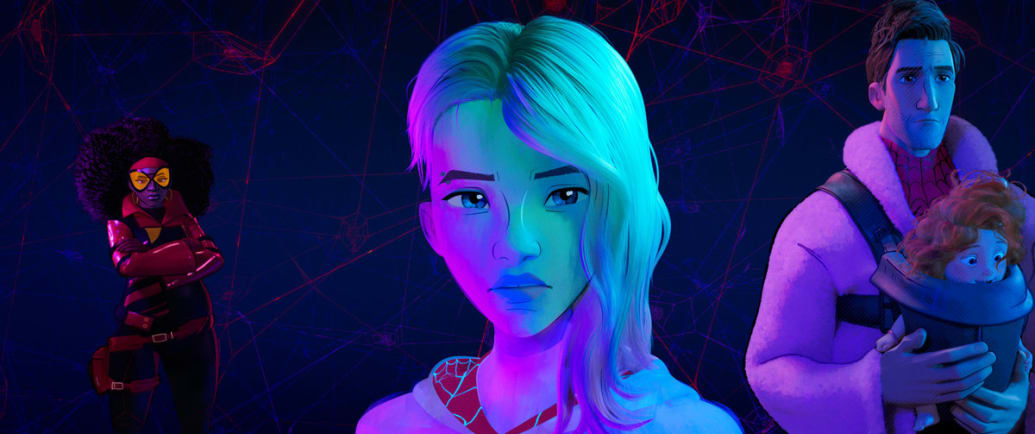Read more of our Spider-Man: Across the Spider-Verse coverage HERE.
Spider-Man: Across the Spider-Verse isn’t just smashing box office expectations and winning over critics—it’s also generated a ton of conversation. Many viewers remain mesmerized by the animation, which is legitimately groundbreaking, meshing countless styles with a unique and thrilling rhythm. Others are discussing which of the new Spider-People is their favorite. But there’s also a surprising debate going on: whether Gwen Stacy, also known as Spider-Gwen (and voiced by Hailee Steinfeld), is trans.
The common conception is that Gwen Stacy is a cisgender woman, as other iterations of the character have been. But while this version of the character appeared in Into the Spider-Verse as well, the conversation about whether or not she is a transwoman picked up after the release of Across the Spider-Verse. Since June 2, fans have presented a wealth of evidence on social media as to her unstated identity, in support of the “Gwen is trans” theory—much of which, they say, comes from Across Spider-Verse itself.
Many of the theorists have pulled their tweets down, due to receiving threats from other users over their argument of Gwen’s gender identity. But those theories may not be off. In fact, after breaking it all down, it may be hard not to agree that Gwen Stacy is, unequivocally, trans.
While there’s nothing in the film that outright states that Gwen is cis, there are symbols that could suggest she is trans. In Gwen’s room, there’s a trans flag with the words “Protect Trans Kids” scrawled on it. Gwen’s father, Captain Stacy, even has a handmade trans flag on his police jacket which is something that no other officer in the film, on Earth-65 or otherwise, has. Spider-Verse also makes great use of color, and blue, pink, and white (the colors of the trans flag) follow her everywhere she goes. These colors are especially prominent in her room and when she swings through the sky—moments where she can be entirely herself. And the trans flag colors are prominent in Gwen’s Spider-Woman super-suit.
“It’s just the colors of her suit! That has nothing to do with being trans!” you may say, in response to this being considered proof of her identity. But before diving into how the evidence for Gwen Stacy’s possible trans identity goes much deeper than the costume, let’s address this common retort. Superhero costumes don’t come randomly assigned. We’ve seen over and over that heroes, particularly Spider-heroes, make their own costumes. Previous Spider-Women have had suits of varying color schemes; the comic’s first Spider-Woman, Jessica Drew, wore red, yellow, and black, for example.
Gwen has no desire to be like the other Spider-Women, typical costume colors included. She tells Miles that “in every other universe, Gwen Stacy falls for Spider-Man. And in every other universe, it doesn’t end well.” It’s no coincidence that the blue and pink Gwen uses on her costumes are the same shade as those on the trans flag in her room or the one that adorns her Captain Stacy’s uniform. Spider-Verse’s Gwen Stacy has made a deliberate choice to use the trans flag colors for her suit.
Notably, these colors don’t dominate Gwen’s costume. The majority of Gwen’s costume is actually black, while the blue is relegated to her shoes and the pink is inside of her hood and on her sleeves. But Gwen placing the trans flag colors under her hood is a perfect way of negotiating her identity: Gwen’s transness doesn’t define who she is; it’s merely one part of her. This very specific use of color in Gwen’s costume, even in small doses, is her way of expressing herself in a way that feels powerful and fulfilling to her. That said, perhaps a later version of Gwen’s costume will find her embracing those colors further, as she continues on her quest of self-acceptance.
But the evidence for Gwen’s trans identity is about so much more than colors. It comes across in her storyline as well. The film starts from Gwen’s perspective, and we see her struggling to fit in anywhere. She’s joined a band but struggling to connect to her bandmates, fearful of letting them in and having them know who she is. Her relationship with her father, while positive, is built on tenterhooks—because of the fear that Captain Stacy will discover she’s Spider-Woman, who has been accused of killing Gwen’s best friend Peter.
Gwen’s sense of self-protection is familiar. Coming out isn’t a one-time thing. The conversation comes up over and over again throughout life. With each new person you meet, there’s a choice that must be made: be open about who you are and risk losing that relationship, or keeping a part of you hidden to fit in. That’s daunting for anyone, but it’s particularly brutal for a teenager.
Presumably, Gwen has already come out to her father as trans, based on the flag on his uniform. But in the film, she outs herself to him again, this time as Spider-Woman. Toward the end of the film, she explains the torment she lives with to him: “They can only know half of who I am,” she says, of her secret superhero identity. That’s a devastating thought for any queer person, and doubly so for a young trans teen.

Sony Pictures Animation
It’s no mistake that when Gwen says this heartbreaking line to her father, the film color palette drenches her in pink, white, and blue. We’re used to hearing tragic stories about trans youth, but Gwen’s father loves her unconditionally: “You’re the best thing I’ve ever done,” he tells her. Parents, if your child comes out of the movie talking about how much they love Gwen (which is valid; she rules), please keep Captain Stacy’s words in mind.
There’s also something to be said of the queerness of nearly all superhero stories. Being a superhero involves tapping into another side of yourself—a side that, in almost every instance, is kept hidden from everyone but the hero themself. But discovering that other facet of who they are—whether it’s swinging webs, super strange, invisibility, teleportation, or anything else—comes euphoria that comes with exploring previously untapped potential. It’s the chance to be your true, unfiltered self, but telling people about it comes with enormous risk. Sound familiar?
The beautiful thing about art is that it’s open to interpretation. Everyone can see something different in the characters and stories of Across the Spider-Verse, but to those who have walked a similar path to Gwen in their lives, her identity is unmistakable. Beyond the surface, Across the Spider-Verse takes great care to have Gwen’s journey reflect that of so many queer youths.
It’s abundantly clear: Gwen Stacy is trans, even if the movie won’t say it out loud.
This post originally appeared on and written by:
Barry Levitt
The Daily Beast 2023-06-13 08:01:00

